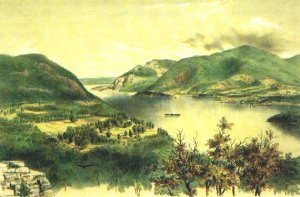





Last Updated: 9/1/99
Then... West Point circa 1859 |
Established in March of 1802 by an Act of Congress, the National Military Academy at West Point was situated on the banks
of the Hudson River on the site of Fort Arnold, built by the Continential Army in 1778 as a temporary fortification of this strategic
bend in the river.
Purchased in 1790 for $11,085, the land on which the Academy was to be built officially became property of the fledgling United States of America. |
Between 1784 and 1794, West Point was occupied by a single company of soldiers whose primary activity was maintaining the decaying fortifications. Finally, in 1794, a Corps of Artillerymen and Engineers was created at West Point. Not yet a formal military academy, this Corps was placed under the supervision of two foriegn officers, Majors Louis Trousard and John Jacob Ulrich Rivardi. On January 10, 1796, a French Officer, Lt. Col. Stephen Rochefontaine assumed command from Trousard and classes began for the training of officers in the building of fortifications.
When fire claimed the only structure suitable for indoor instruction only two months later, classes were suspended and did not resume on a regular basis until July 2, 1801 with the ordering of cadets to West Point by Secretary of War, Henry Dearborn. President Thomas Jefferson signed the act that officially authorized the United States Military Academy in March of 1802.
In May of 1802, plans were drawn for the Academy which was to cost $1,500 for the construction of a mathematics room, a drafting room, quarters for the cadets, two mess rooms, and quarters for the officers, teachers, surgeon and their families. The early curriculum consisted of the rudiments of mathematics and military fortification since some newly arriving cadets could not read or write while most had only a basic knowledge of arithmetic and grammar. It was only required that officers of the day have the most basic, practical understanding of mathematics to lay artillery correctly, to construct simple fortifications and to draw rough maps. It wasn't until Sylvanus Thayer became Superintendent in 1817 that West Point began to offer more than a very basic engineering education.
Of fifty officers commissioned during Thomas Jefferson's eight years in office, fourteen were made Engineers, twenty-seven were sent to Artillery, eight to Infantry, and one to the Dragoons. (One additional cadet was graduated but not offered a commission.)
Now... West Point - Today |
The United States Military Academy of today reflects the pride and acomplishment of 200 years of dedication to "Duty, Honor, Country." The Class of 2002 is comprised of 1,054 men and 192 women, 74 percent of whom ranked in the upper 20 percent of their high school classes and include 78 Valedictorians, 38 Salutatorians, 233 National Merit Scholars and 732 Members of the National Honor Society.
Among the Bicentennial Class of 2002 are 222 High School Class Presidents, 191 School Newspaper Editors, 159 Class Yearbook Editors, 155 Members of their High School Debating Team, 139 Eagle Scouts, 774 Varsity Team Captains and 1,116 Varsity Letter Winners in Athletics.
The Class of 2002 includes cadetsfrom every state in the United States, and includes not only Congressional appointees but also those who gained appointment through military service sources. Several international cadets under sponsorship of their respective countries also entered the Class of 2002, including two each from Bulgaria, Barbados, Croatia and Romania, and one each from Costa Rica, Latvia, Cameroon, Slovenia and Turkey.
| Music Control |

Click above to sign our Guest Book.
Questions and comments are invited via E-mail.
